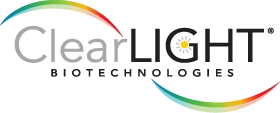
ClearLight FAQs
Frequently Asked Questions
Answers about our CLARITY Tissue Clearing, 3D Imaging, IHC and More.
Services
It really depends upon your specific research questions. ClearLight Lab Services are a customized collaborative process. Our goal is to make sure the analytics we provide are specific to your research question(s). To get started, let’s have a discussion.
- Diagnostic biomarkers allow for the early detection of a disease in a noninvasive way
- Predictive biomarkers are used to predict the response of the patient to a particular therapy
- Prognostic biomarkers give information about the health outcome for a patient using clinical or biological data that provides information on the expected course of the disease
It can be both, for a pilot it could be a new tissue or a new tissue and new antibodies. If at any point we have to optimize an antibody, then it becomes antibody feasibility.
We perform a concentration and titration assessment that evaluates the optimal concentration level of any given tissue preferably done with control tissues.
ClearLight Biotechnologies’ technology could be easily applied to most biological areas that rely on 2D thin-section analysis of a tissue. Bring us your burning question even if it is outside the area of oncology or neuroscience.
No. ClearLight Biotechnologies provides study-related services to sponsors of drug research programs early in the drug development cycle. Our contract research and development services are for Research Use Only (RUO).
We currently perform non-destructive tissue processing to facilitate pre-clinical research studies.
See Sample Requirements on the Services page. We may support situations not shown. Start a conversation with us using the Contact Us form, email, call (408) 329-7769 or chat with us online.
ClearLight provides CLARITY Tissue Clearing Kits to researchers who wish to perform lipid clearing of soft tissues on their own using the CLARITY method. Visit the online store to learn more about these products. Researchers can also engage lab services for CLARITY Tissue Clearing, 3D Immunohistochemistry and Tru3D Tissue Analysis. Visit Services to learn more.
Technology
The value of tissue clearing comes from utilizing samples that are thick enough to be affected by light-scatter, so usually they would be more than 200 microns in thickness. That being said, we have done some work with other samples that have come very close to the lower end of that thickness and have good success in applying our technology. We recommend a brief chat with our Science Team to assess your fit if you are still unsure.
Our process is simple. Researchers provide us with their fixed, frozen or FFPE tissue samples. Our team will then embed, clear, and immunostain your samples. Next, we image the samples using fluorescent microscopy and perform 3D image analysis of the microenvironment and/or sample. Researchers receive a summary report and data that reflects the research questions posed. Learn more.
We use CLARITY tissue clearing to render opaque tissues primed for deep tissue imaging. Once tissues are lipid-cleared they can be immunostained and imaged in 3D. We have found the order clear-stain-image matters. See our Tissue Clearing Comparison
Imaging biomarkers in 3D reveals novel insights not available with other technologies. Biological tissues are complex and intrinsically 3-dimensional. We work with researchers who want to view spatial relationships in X, Y, and Z dimensions to gain new understanding of the tissue microenvironment.
- Diagnostic biomarkers allow for the early detection of a disease in a noninvasive way
- Predictive biomarkers are used to predict the response of the patient to a particular therapy
- Prognostic biomarkers give information about the health outcome for a patient using clinical or biological data that provides information on the expected course of the disease
ClearLight uses DAPI (pronounced ‘DAPPY’) as a nuclear counterstain in fluorescence microscopy. Its blue fluorescence stands out in vivid contrast to the red, green, and yellow fluorescent probes of other antibodies.
ClearLight’s technology is being developed to eventually evaluate true 3D relationships within a volume of diseased and normal tissue. By examining the tissue in a 3D volume, the CLARITY platform will allow a better understanding of the molecular heterogeneity within that tumor sample. The up and coming, Tru3D™ analysis software will be able to process image files of multiplex IHC stained tissues and analyzes the tissue sample in 3D. The current proprietary 3D Software workflow is Raw Data –> Cell Segmentation –> Classification –> Analysis. Samples in our published papers were imaged on a Leica SP8 confocal microscope and using Bitplane Imaris 9.2.1 software as this was prior to the development of our proprietary software. Learn More.
Active or passive CLARITY tissue clearing is a very powerful and useful method, but lipid clearing and staining times take longer time than optimal for use in future clinical and diagnostic settings. CRYSTAL technology is a significant improvement to both the active and passive CLARITY tissue clearing methods by aiming detergent streams at specific areas of the tissue sample to be cleared. This can speed up the clearing process significantly, increasing the diagnostic relevance and usefulness of this technology in a clinical setting.
ClearLight Biotechnologies has signed an exclusive worldwide licensing agreement to develop and commercialize CRYSTAL, a three-dimensional (3-D) tissue-clearing technology. Learn more about CRYSTAL on the resources page.
Staining can be performed on the tissue sample without interference from the hydrogel matrix. With CLARITY tissue clearing, the sample is processed via Multiplex IHC staining, allowing the characteristics of the tumor microenvironment to be fully analyzed in three dimensions.
The tissue sample is with a hydrogel matrix solution, allowing covalent cross-linking of biological molecules to the hydrogel resulting in a matrix that remains intact even as light scattering lipids are cleared away.
The CLARITY method utilizes specific detergents, to remove the lipids, or fatty tissues, from a tissue sample.
CLARITY was first made public in a paper published in Nature in 2013.
[ K Chung, J Wallace, S-Y Kim, S Kalyanasundaram, AS Andalman, TJ Davidson, JJ Mirzabekov, KA Zalocusky, J Mattis, AK Denisin, S Pak, H Bernstein, C Ramakrishnan, L Grosenick, V Gradinaru, and K Deisseroth. Structural and molecular interrogation of intact biological systems. Nature (2013) 497: 332-337.]
No, the CLARITY method was originally developed at the Karl Deisseroth Lab at Stanford University Medical Center. Dr. Deisseroth is a founder and scientific advisor to ClearLight Biotechnologies. However, ClearLight is automating the method so that it can be utilized by researchers and eventually clinicians across the world.
CLARITY is an acronym for Clear Lipid-exchanged Acrylamide-hybridized Rigid Imaging / Immunostaining / in situ-hybridization-compatible Tissue hYdrogel. Learn more about our technology.
Tissue Clearing Kits
There are many factors including tissue type and size. Here are recommended starting time points for select tissues using the appropriate lipid content kit:
| Tissue/Organ | <1 mm thick | 1-2 mm thick | ½ organ | Whole organ |
|---|---|---|---|---|
| Brain | 1 day | 2-3 days | 7 days | 14 days |
| Lung | 1 day | 1-2 days | 3 days | 7 days |
| Kidney | 1 day | 1-2 days | 7-8 days | 15 days |

